12 Types of Detaché Violin Bowing Technique
Detaché is the default way of bowing, but there are many nuances
In this article I explain 7 different types of detaché and how they look like in sheet music (notation) with examples from violin repertoire.
#1 Simple standard detaché
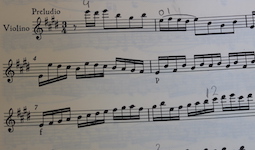 This would be default bowing: one bow stroke per note. The transitions between the notes aren’t particularly fluent, but also not accented. There is no variation in pressure. Examples are in Bach’s partita in E major, Paganini’s 16th caprice and the 1st movement of the Viotti concerto no 22 (16th notes).
This would be default bowing: one bow stroke per note. The transitions between the notes aren’t particularly fluent, but also not accented. There is no variation in pressure. Examples are in Bach’s partita in E major, Paganini’s 16th caprice and the 1st movement of the Viotti concerto no 22 (16th notes).
#2 Accented grand detaché
These are large long accented bow strokes with a lot of bow speed, energy and a big tone. This can be played with and without bite. Some might describe this as martelé. Know that different names are often used for the same bowing technique depending on the book and the teacher or performer.
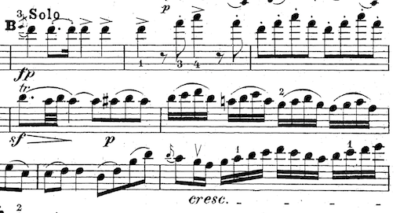 Examples:
Examples:
- Praeludium and allegro by Kreisler-Tartini (with bite)
- Beethoven violin concerto measures 124 to 142 (no bite)
- Tartini’s Devil’s Trill Sonata, 2nd movement (measures 21-23 after double bar, accented trills)
- Opening of the Brahms violin concerto (with bite)
- Opening of Mozart’s violin concerto in D major (no bite)
In music notation it’s indicated by the accents you see in the picture.
Is this interesting? Share it on Twitter and look smart:
#3 Finger detaché
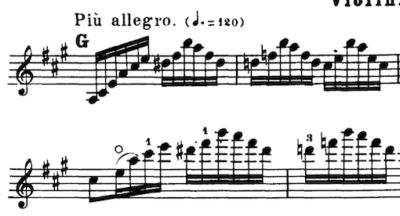 The name is a bit misleading as this technique is produced with the fingers and a relaxed and flexible wrist. The arm is as still as possible. This gets you a very efficient, small détaché for extremely fast and light passages. The last page of Saint-Saëns’ Introduction and Rondo Capriccioso (the Allegro) would be an example.
The name is a bit misleading as this technique is produced with the fingers and a relaxed and flexible wrist. The arm is as still as possible. This gets you a very efficient, small détaché for extremely fast and light passages. The last page of Saint-Saëns’ Introduction and Rondo Capriccioso (the Allegro) would be an example.
The weight you put in the bow prevents the bow from jumping, otherwise this would become a sautillé.
#4 Louré
This can apply to one or several slurred notes. The dynamic is like a belly: the note starts softly, swells and diminishes again. This is achieved by changing pressure with the index finger. You can find an example in the Allamande of Bach’s 2nd partita.
You don’t really see a marking of this in sheet music. The sound and technique are very close to portato.
#5 Accented detaché without bite
 The notes are clearly separated and start with an accent, like in the shown fragment of the Mozart violin concerto in D Major and in Praeludium and Allegro by Kreisler.
The notes are clearly separated and start with an accent, like in the shown fragment of the Mozart violin concerto in D Major and in Praeludium and Allegro by Kreisler.
# 6 Accented detaché with bite
 The note starts with an accent that has the bite from a martelé.
The note starts with an accent that has the bite from a martelé.
You can find this in the 1st movement of the Saint-Saëns concerto and in the 4th movement of the Franck sonata.
FREE Violin Scale Book
Sensational Scales is a 85 page violin scale book that goes from simple beginner scales with finger charts all the way to all three octave scales and arpeggios

Hi! I'm Zlata
Classical violinist helping you overcome technical struggles and play with feeling by improving your bow technique.
#7 Detaché Porté
This is a swelling on each note done by the bow speed. In Brahms sonata op 100 you can find an example in the half notes and in measures 139-139 of the 1st movement of the 2nd violin concerto by Prokofiev. There’s no special notation of this in the sheet music.
#8 Detaché Lancé
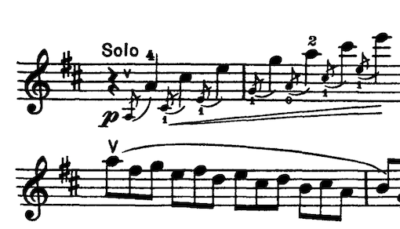 Lots of sources call this martelé lancé as the high speed and accent is more martelé. An example would be the opening of the Beethoven violin concerto. There’s no special notation of this in the sheet music.
Lots of sources call this martelé lancé as the high speed and accent is more martelé. An example would be the opening of the Beethoven violin concerto. There’s no special notation of this in the sheet music.
#9 Detaché Collé
In this bow stroke you lift the bow at the bow changes, creating a sort of slow motion spiccato with full bow control. Depending on the performance you can find it in the Fuga of Bach’s 1st violin sonata. There’s no special notation of this in the sheet music.
#10 Slap Stroke or Jeter
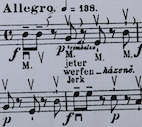 This is a quick vertical slap creating a firm accent. This is usually done at the frog or the tip, as in the middle of the bow it would get you a ricochet, uncontrolled bouncing or at least not a marked sound. It can be done up bow or down bow.
This is a quick vertical slap creating a firm accent. This is usually done at the frog or the tip, as in the middle of the bow it would get you a ricochet, uncontrolled bouncing or at least not a marked sound. It can be done up bow or down bow.
You can find a lot of exercises in Sevcik’s 40 variations, as this is great for bow control.
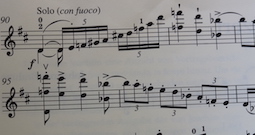 Examples:
Examples:
- Saint-Saëns – Violin concerto nr 3 – 3rd movement
- Lalo – Symphonie Espagnol – opening of the 1st movement
- Brahms – Violin concerto – 1st movement (opening solo, 12th and 13th notes)
- Wieniawski – Concerto in d minor – 1st movement (high B flat)
In sheet music it’s often marked by a comma above or after the note.
#11 Whipped Stroke or Fouetté
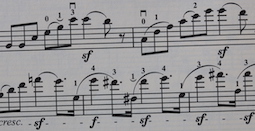 Just as the previous bow stroke, some would definitely categorize this one as a type of martelé, but again: books, teachers and performers differ.
Just as the previous bow stroke, some would definitely categorize this one as a type of martelé, but again: books, teachers and performers differ.
You lift the bow and give a quick accent at the tip on the up bow.
Examples:
- Mendelssohn – Violin Concerto – 1st movement (see example in this video)
- Beethoven – Concerto in D – Finale (measures 68-69)
- Wieniawski – Concerto in D Minor – 3rd movement (measures 272-273)
In sheet music you wont see a special marking except for the bow division, slurs and transitions between notes. You’d have to let the character of the piece and performance tradition lead you.
# 12 Son filé
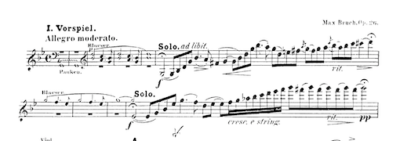 This is bowing with a deep and full tone like in the beginning of the Bruch violin concerto. Again, no special marking in the sheet music except that you know these are long bow strokes and the dynamics would be forte.
This is bowing with a deep and full tone like in the beginning of the Bruch violin concerto. Again, no special marking in the sheet music except that you know these are long bow strokes and the dynamics would be forte.
There’s everything in between!
If you take a deep dive into all the examples you will notice that these twelve types of detaché violin bowing technique are not black and white. All examples are played a bit differently and some types overlap.
Keep making music!
Focus on your sound ideal and the emotion you want to express in your music
Don’t get stuck in thinking which type of bowing you’re actually using. These distinctions are purely theoretical to help you find connections between technique used in repertoire.
Make sure to watch this video in which I explain and show more violin bowing techniques.

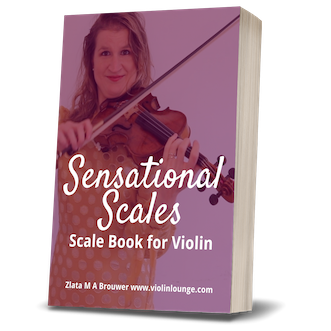
Overwhelmed at the detailed analysis.. So much variety of sounds… Good to know and feel humbled…. Wonder if I would ever play these different techniques… Happy climbing small hills… Good to know Mt Everest exists… Zlata, you amaze me with the efforts you have put in to tabulate these techniques.
Thank you so much, Manoj. Don’t worry too much about them. In the end it’s about constantly adjusting and using the components of sound you’re learning in Bow like a Pro. If I’m playing, I’m not wondering which of the twelve detachés I’m using.
Thank you for your detailed website with examples. It is
greatly appreciated.
Glad it’s helpful to you!